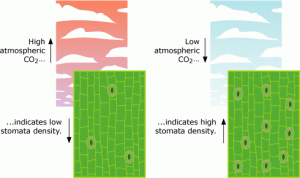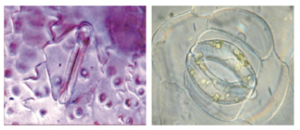Findings from a pharaoh
What can an Egyptian pharaoh from 1300 BC tell us about how plants will respond to 21st century environmental change?

Photo credit – Discovery Times Square Museum (Available: http://www.discoverytsx.com/exhibitions/kingtut).
When Howard Carter discovered King Tutankhamun’s tomb in 1922, the boy pharaoh’s treasures captivated the world. Amidst such splendor, olive leaves found in the burial chamber were overlooked. But, in 1993, two botanists, David Beerling and William Chaloner decided to compare these leaves with their modern counterparts. They found that olive leaves grown today have 33% fewer stomata (tiny ‘pores’ on the leaf surface) than they did in 1300 BC. Beerling & Chaloner linked this decline in stomata to increasing carbon dioxide (CO2) levels.

Photo credit – University of California Museum of Paleontology’s Understanding Evolution (http://evolution.berkeley.edu).
Powerful pores
Stomata (singular – stoma) are vital to plant function. Plants use these pores to ‘breathe’. Stomata allow CO2 to enter a leaf, where it is used in photosynthesis to generate sugars, which the plant needs to survive and grow. The trade-off is stomata also let water escape. Plants, therefore, need to balance CO2 gain and water loss.

Photo credit – University of California Museum of Paleontology’s Understanding Evolution (http://evolution.berkeley.edu).
Rising CO2 – a certainty in an uncertain world
CO2 is the most well known of the greenhouse gases. These gases trap the Sun’s heat within Earth’s atmosphere, causing our planet to warm up. We produce CO2 every day when we burn oil, gas and coal to drive our cars, heat our homes and power our factories.
This has caused CO2 levels to increase by 40% since the industrial revolution started in 1750 (IPCC, 2014). CO2 levels are predicted to increase more rapidly in the future as populations and economies grow (IPCC, 2014).
With some exceptions (Bettarini et al., 1998), most scientists agree that this rise in CO2 will cause a decline in stomatal density (Woodward & Kelly, 1995; Lin et al., 2001). Paoletti et al. (1998) showed that stomata numbers will decline until CO2 levels reach 750 μmol mol-1.
But, how will this change impact plant function?
Some plants naturally have few stomata because they have a change in the gene that controls stomatal development (Gray et al., 2000). As CO2 levels rise, each stoma will be able to bring in more CO2. So, a leaf will need fewer stomata to bring in the same amount of CO2.
A leaf with fewer stomata will lose less water. As a result, the plant will have a higher water use efficiency and so has an advantage over others (Drake et al., 1997). With time, CO2 will act as a selection pressure and these plants will become more common.

Photo credit – University of California Museum of Paleontology’s Understanding Evolution (http://evolution.berkeley.edu).
Future plants will be better able to conserve water, making them more tolerant to periods of water stress (Woodward, 1987). This is just as well as droughts are predicted to become more common (IPCC, 2014). It will also mean we will be able to grow the same amount of crops, but using less water (Drake et al., 1997).
Stomata transfer water from the land to the atmosphere. If plants have fewer stomata, less water will be transferred, which will cause increased air temperatures and runoff (Kürschner et al., 1997).
The olive leaves from King Tut’s tomb showed that stomata respond to CO2 levels. With rises in CO2 predicted for the 21st century, perhaps the insights provided by these leaves are the boy pharaoh’s most valuable treasure.
References
Beerling, D.J. & Chaloner, W.G. (1993) Stomatal density responses of Egyptian Olea europaea L. leaves to CO2 change since 1327 BC. Annals of Botany. 71(5), 431-435.
Bettarini, I., Vaccari, F.P. & Miglietta, F. (1998) Elevated CO2 concentrations and stomatal density: observations from 17 plant species growing in a CO2 spring in central Italy. Global Change Biology. 4(1), 17-22.
Drake, B.G., Gonzàlez-Meler, M.A. & Long, S.P. (1997) More efficient plants: a consequence of rising atmospheric CO2? Annual review of plant biology. 48(1), 609-639.
Gray, J.E., Holroyd, G.H., Van Der Lee, F.M., Bahrami, A.R., Sijmons, P.C., Woodward, F.I., Schuch, W. & Hetherington, A.M. (2000) The HIC signalling pathway links CO2 perception to stomatal development. Nature. 408(6813), 713-716.
IPCC (2014) Summary for Policymakers. In: Pachauri. R.K. & Meyer, L.A. (eds.) Climate Change 2014: Synthesis Report. Contribution of Working Groups I, II and III to the Fifth Assessment Report of the Intergovernmental Panel on Climate Change. IPCC, Geneva, Switzerland, pp. 1-31.
Kürschner, W.M., Wagner, F., Visscher, E.H. & Visscher, H. (1997) Predicting the response of leaf stomatal frequency to a future CO2-enriched atmosphere: constraints from historical observations. Geologische Rundschau. 86(2), 512-517.
Lin, J., Jach, M.E. & Ceulemans, R. (2001) Stomatal density and needle anatomy of Scots pine (Pinus sylvestris) are affected by elevated CO2. New Phytologist. 150(3), 665-674.
Paoletti, E., Nourrisson, G., Garrec, J.P. & Raschi, A. (1998) Modifications of the leaf surface structures of Quercus ilex L. in open, naturally CO2-enriched environments. Plant, Cell & Environment. 21(10), 1071-1075.
Woodward, F.I. & Kelly, C.K. (1995) The influence of CO2 concentration on stomatal density. New Phytologist. 131(3), 311-327.
Woodward, F.I. (1987) Stomatal numbers are sensitive to increases in CO2 from pre-industrial levels. Nature. 327(6123), 617-618.
Word count: 499



Recent Comments